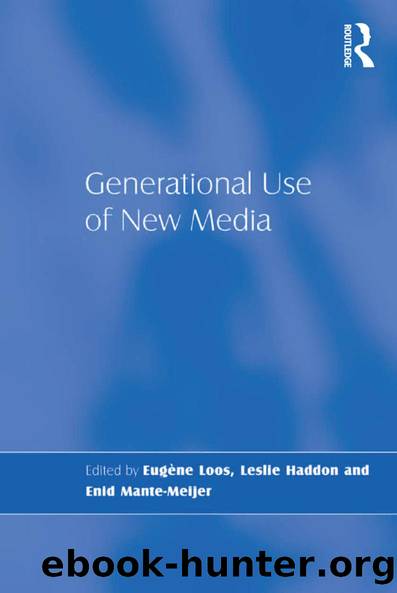Generational Use of New Media by Leslie Haddon Enid Mante-Meijer Eugène Loos

Author:Leslie Haddon, Enid Mante-Meijer, Eugène Loos [Leslie Haddon, Enid Mante-Meijer, Eugène Loos]
Language: eng
Format: epub
ISBN: 9781409483434
Barnesnoble:
Publisher: Ashgate Publishing Ltd
Published: 2012-10-28T00:00:00+00:00
References
Campbell, C. (1992), âThe desire for the new: Its nature and social location as presented in theories of fashion and modern consumerismâ, in Silverstone, R. and Hirsch, E. (eds), Consuming Technologies: Media and Information in Domestic Spaces (London, New York: Routledge).
Castells, M. (2000), Informationsåldern: ekonomi, samhälle och kultur (Göteborg: Daidalos).
Chapman, S.A. (2005), âTheorizing about aging well: Constructing a narrativeâ, Canadian Journal on Aging, 24 (1), 9â18.
Chapman, S.A. (2006), âA ânew materialistâ lens on aging well: Special things in later lifeâ, Journal of Aging Studies, 20 (3), 207â216.
Corsten, M. (1999), âThe time of generationsâ, Time & Society, 8 (2), 249â272.
Dannefer, D. (1988), âWhatâs in a name? An account of the neglect of variability in the study of agingâ, in Birren, J.E. and Bengtson, V.L. (eds), Emergent Theories of Aging (New York: Springer).
Dunér, A. and Nordström, M. (2005), âIntentions and strategies among elderly people: Coping in everyday lifeâ, Journal of Aging Studies, 19 (4), 437â451.
Ekerdt, D.J., Sergeant, J. F., Dingel, M. and Bowen, M.E. (2004), âHousehold disbandment in later lifeâ, The Journals of Gerontology, Series B: Psychological Sciences and Social Sciences, 59 (5), 265â273.
EU (Cordis) (2011), ICT â Information and Communication Technologies Work Programme 2011â121. Available at: <http://ftp.cordis.europa.eu/pub/fp7/ict/docs/ict-wp-2011-12_en.pdf> (accessed 15.01.2011).
Eyreman, R.T. and Turner, B.S. (1998), âOutline of a theory of generationsâ, European Journal of Sociology, 1 (1), 91â106.
Featherstone, M. (1995), âPost-bodies, aging and virtual realityâ, in Featherstone, M. and Wernick, A. (eds), Images of Aging: Cultural Representations of Later Life (London, New York: Routledge).
Findahl, O. (2010), Svenskarna och Internet. 2010 (Hudiksvall: World Internet Institute).
Giele, J.Z. and Elder jr, G.H. (1998), âLife course research: Development of a fieldâ, in Giele, J.Z. and Elder jr, G.H. (eds), Methods of Life Course Resarch. Qualitative and Quantitative Approaches (London etc.: Sage).
Godfrey, M., Townsend, J. and Denby, T. (2004), Building a Good Life for Older People in Local Communities. The Experience of Ageing in Time and Place (York: Joseph Rowntree Foundation).
Hagberg, J.-E. (2004), âOld people, new and old artefacts: Technology for later lifeâ, in Ãberg, B.-M., Närvänen, A.-L., Näsman, E. and Olson, E. (eds), Changing Worlds and the Ageing Subject: Dimensions in the Study of Ageing and Later Life (Aldershot: Ashgate).
Hagberg, J.-E. (2008), Livet genom tekniklandskapet. Livslopp, åldrande och vardagens förändring. [The life through the technology landscape. Life course and ageing in a changing everyday life]. Skrifter från NISAL, Vol. 2008, 1 (Linköping: Linköpings universitet).
Hagberg, J.-E. (2011), à ldrande på landsbygden. Att leva som äldre i Ydre, Skrifter från NISAL, Vol 2011, 1 (Linköping: Linköpings universitet).
Haraway, D. (1991), âA cyborg manifesto: Science, technology and socialist feminism in the late twentieth centuryâ, in Haraway, D. (ed.), Simians, Cyborgs and Women: The Reinvention of Nature, (London: Free Association Books).
Hagberg, J.-E., Burdick, D.C. and Sunkoy Kwon (eds) (2007), âGerotechnology: Research and practice in technology and aging â A textbook and reference for multiple disciplinesâ [Book review], Ageing & Society, 27, 1, 171â172.
HÃ¥rd, M. and Jamison, A. (2005), Hubris and Hybrids: A Cultural History of Technology and Science (London, New York: Routledge).
Ihde, D. and Selinger, E. (2003), Chasing technoscience: matrix for materiality (Bloomington, Ind.
Download
This site does not store any files on its server. We only index and link to content provided by other sites. Please contact the content providers to delete copyright contents if any and email us, we'll remove relevant links or contents immediately.
Cecilia; Or, Memoirs of an Heiress — Volume 1 by Fanny Burney(32495)
Cecilia; Or, Memoirs of an Heiress — Volume 2 by Fanny Burney(31909)
Cecilia; Or, Memoirs of an Heiress — Volume 3 by Fanny Burney(31892)
The Great Music City by Andrea Baker(31756)
We're Going to Need More Wine by Gabrielle Union(19003)
All the Missing Girls by Megan Miranda(15775)
Pimp by Iceberg Slim(14433)
Bombshells: Glamour Girls of a Lifetime by Sullivan Steve(14021)
For the Love of Europe by Rick Steves(13558)
Talking to Strangers by Malcolm Gladwell(13290)
Norse Mythology by Gaiman Neil(13278)
Fifty Shades Freed by E L James(13186)
Mindhunter: Inside the FBI's Elite Serial Crime Unit by John E. Douglas & Mark Olshaker(9260)
Crazy Rich Asians by Kevin Kwan(9220)
The Lost Art of Listening by Michael P. Nichols(7453)
Enlightenment Now: The Case for Reason, Science, Humanism, and Progress by Steven Pinker(7272)
The Four Agreements by Don Miguel Ruiz(6700)
Bad Blood by John Carreyrou(6581)
Weapons of Math Destruction by Cathy O'Neil(6214)
